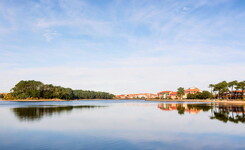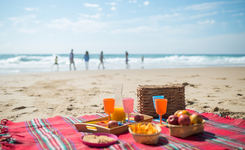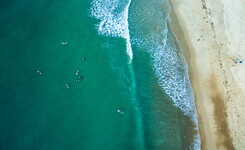Surfing for beginners: we answer all your questions
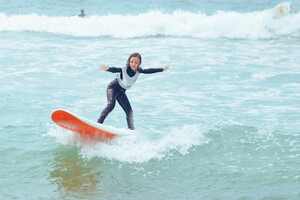
Surfing is an exciting activity that attracts many thrill-seekers. If you've always dreamed of riding perfect waves, this article is for you! At the 5-star Lou Pignada family campsite in Messanges, in the south-west of the Landes region in France, we'll help you understand the basics of surfing for beginners so you can get the most out of your experience on the board. How to surf will soon no longer be the question you ask yourself. What will matter next is how you enjoy being in the water with your board without even thinking about it 🏄

1. What is surfing for beginners?
Surfing for beginners is an introduction to an exciting and demanding water sport that attracts enthusiasts from all over the world. Surfing encompasses several fundamental aspects, going far beyond the simple act of standing on a board.
- Choosing the right surfboard is a crucial step. Surfboards vary considerably in size, shape and material, and each model is designed to meet specific needs.
- Understanding how to read the waves is an essential skill for beginners to acquire. This involves learning to recognise the different wave formations, where they break, and the tidal and wind conditions that influence their formation.
- The learning process also includes basic techniques, such as board position, paddling movement and the action of going from lying down to standing up in one fluid movement.
All in all, surfing for beginners is an enriching introduction to a sport that combines fun, adrenaline and a deep respect for nature. With practice and patience, everyone can look forward to catching their first waves and savouring the unique sensation of gliding across the water.

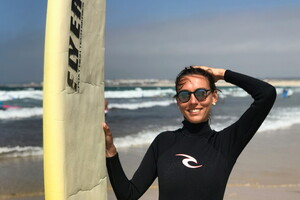
2. Is it possible to learn to surf as an adult?
Absolutely! Every year, many adults discover the pleasure of surfing for the first time. The common misconception that surfing is a sport for young people is wrong. Surfing has no age limit. In fact, many people start surfing after the age of 30, 40, 50 or even older, regardless of their previous sporting experience.
To master surfing, you need determination. As with any new sport, it's essential to be ready for a challenge. The first few lessons can be frustrating, but with perseverance you'll start to feel more and more comfortable on the board. Having the will to improve and learn not only helps you to make progress, but also to get the most out of the experience.
The right surf lessons are essential. Many surf schools offer programmes specially designed for adults. These courses take into account the physical and psychological particularities of the learners. A good instructor will be able to guide you, correct your posture, teach you the safety rules, and give you the confidence to enjoy every session. Lessons in small groups or even private sessions can also be very beneficial.
In short, learning to surf as an adult is not only possible, it can also be one of the most rewarding adventures of your life. With a positive attitude, the right lessons and genuine determination, you'll discover the fascinating world of surfing and all it has to offer.

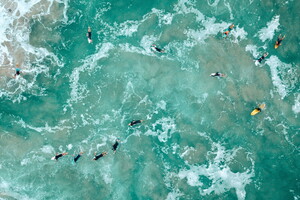
3. How do I learn to surf?
Learning to surf for beginners can be an exciting and rewarding experience, but it requires a methodical and considered approach. Here's a detailed breakdown of the key steps to starting your adventure in this water sport.
Take surfing lessons from qualified instructors
For novices, it's highly recommended to take surfing lessons with certified instructors. These professionals have not only the technical skills needed to teach, but also knowledge of safety in the water.
- Teaching objectives: surf lessons will teach you the fundamentals, such as board position, pop-up (transition to stand up on the board) and balance. They will also familiarise you with safety principles, such as recognising wave conditions and potential dangers, such as currents or rocks.
- Evaluating your progress: an instructor will be able to give you constructive feedback tailored to your progress, making your learning more effective. Taking part in group lessons can also provide a friendly and motivating learning environment.

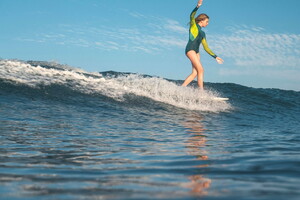
Choosing the right surfboard for beginners
The choice of surfboard is crucial to your learning curve. Good boards for beginners are generally wider and more stable, making it easier to get your balance right.
- Types of board: foam boards, for example, are ideal for beginners because they are light, offer great buoyancy and are less dangerous in the event of a fall. Longer boards also make it easier to catch waves.
- Individual adjustment: it's also important to take your height, weight and fitness level into account when choosing the most suitable board.
Train regularly to make rapid progress
Regular practice is essential for mastering surfing techniques and feeling comfortable in the water.
- Repetition of movements: devote some time to repeating the basic movements, such as standing up and positioning yourself on the board. Repetition will help strengthen muscle memory, making the movements more natural over time.
- Frequency of sessions: try to arrange to go surfing several times a week, if possible. This will allow you to get used to the different surfing conditions (waves, currents, tides) and build your confidence in the water.
- Analyse your performance: after each session, take a few minutes to reflect on what you've learnt, what worked well and what needs to be improved.

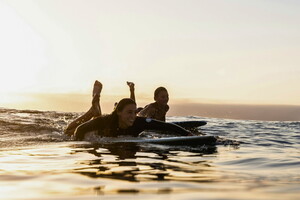
4. How to start and progress in surfing?
To begin and progress in surfing, it's essential to choose an environment that's conducive to learning. Opting for small waves, which are often quieter and less powerful, means that novices are not intimidated by the force of the ocean. These small waves offer an ideal training ground for familiarising yourself with the board and basic movements without the pressure of big waves.
Consistent surfing is a key factor in making rapid progress. Each beginner surf session exposes you to new conditions and waves, enriching your experience and helping you develop your intuition about how to position yourself and paddle. As you gain confidence, you'll gradually be able to try bigger and more complex waves, pushing you out of your comfort zone.
Finally, remember that every experience, whether positive or negative, contributes to your overall learning. Sometimes you'll fall, but that's part and parcel of the process. Analysing your mistakes and successes after each session is essential; it will enable you to correct your shortcomings and improve your performance. The most important thing to remember is that surfing is not only a physical activity, but also an art that requires patience, perseverance and, above all, an open attitude to learning. Let every wave teach you something new and enjoy the journey, because surfing is as much a personal adventure as it is a sport.


5. Can you learn to surf on your own?
It's entirely possible to learn to surf on your own, but there are some major challenges involved. The first thing to consider is that surfing is a sport that requires a good understanding of sea conditions, safety and appropriate techniques. Although some self-taught surfers have managed to develop their skills without the help of an instructor, they have often invested time in training themselves, by watching other surfers or studying specialist videos and books.
However, it's highly advisable to take a beginner's surfing course when you're just starting out. This has a number of advantages. Firstly, an experienced instructor can give advice tailored to your level, helping you to better understand how to read the waves, choose the right spot for the conditions and adopt the right posture on the board. A surfing professional will also teach you essential safety rules, such as how to behave in the sea, how to avoid collisions with other surfers and the importance of knowing yourself and assessing your abilities before taking the plunge.
It's also crucial to bear in mind that surfing, especially for beginners, can be dangerous. Waves can be unpredictable, and poor judgement about currents or the seabed can quickly lead to perilous situations. A course will enable you to learn to assess these risks with the help of an expert, rather than facing them alone and potentially putting yourself in danger.


6. What type of surfing course should I choose if I'm a beginner?
- Group lessons: group lessons are ideal for beginners, as they allow you to benefit from a group dynamic. By sharing the experience with other aspiring surfers, you'll have the chance to learn while having fun. What's more, being in a group helps to create a friendly and supportive environment, where everyone can motivate each other.
- Private tuition: if you're looking for a more personalised learning experience, opt for private tuition. These sessions allow you to benefit from individual attention from the instructor, who can assess your level and tailor the lessons to your specific needs. You'll be able to progress at your own pace, receive detailed technical advice and work on specific aspects of surfing for beginners.
- Intensive courses: for those who want to dive into the world of surfing quickly, intensive courses can be an excellent option. These multi-day programmes combine theory, practice and personalised coaching, allowing you to maximise your progress in a short space of time.
- Advanced courses: if you already have some basic surfing experience and want to improve your skills, consider advanced courses. These sessions are generally suitable for intermediate and advanced surfers, and focus on refining techniques, learning new manoeuvres, and developing better wave reading skills.


7. Where can you learn to surf near camping Lou Pignada?
Close to the Lou Pignada campsite, surf enthusiasts have the opportunity to immerse themselves in the fascinating world of this sport thanks to several surf schools, including the renowned MANA SURF SCHOOL, located on the beach at Messanges Sud. This is a great place for beginners to learn to surf, and is renowned for its ideal conditions.
With MANA SURF SCHOOL, you have the chance to discover surfing from the age of 6, in a natural setting stimulated by the passion and expertise of qualified instructors. The school offers a range of courses to suit everyone's needs and desires:
- Group lessons: designed for individuals, groups or families, these 1? hour lessons allow you to discover surfing while having fun with other surfing enthusiasts. With a maximum of 8 students per instructor, each participant benefits from personalised attention, expert guidance and a friendly atmosphere.
- Private lessons: for those who want even more focused attention, private lessons are the ideal solution. With a maximum of 3 people per session, you'll have an instructor at your disposal for 1 hour. This allows you to make rapid progress, adapted to your level and your needs.
- Family Pack: this package is designed for families of 3 or more who want to share a surfing experience for beginners or advanced surfers at a special price. The course lasts 1h30 and the maximum number of students per instructor remains the same at 8, guaranteeing a rich and enjoyable experience for the whole family.

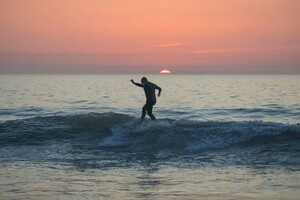
8. How much does it cost to learn to surf?
Prices for learning to surf can fluctuate considerably depending on a number of factors, including geographical location, the reputation of the surf school, the length of the lessons and the services included. On average, you can expect to pay between €30 and €60 for a surf lesson lasting one to one-and-a-half hours.
Some schools offer packages that include several lessons at a reduced rate. Schools may also offer group lesson options, which are generally cheaper per session than private lessons. Prices may also vary according to the season. During the high summer season, when demand is greatest, prices tend to rise. Conversely, in the low season, some schools may offer promotions or discounts to attract new customers.
Finally, it's worth checking what's included in the price. Some surf schools include board and wetsuit hire in the price, while others may charge extra for this equipment. It is therefore advisable to read the details of the offer carefully and find out about any additional costs before booking a lesson.

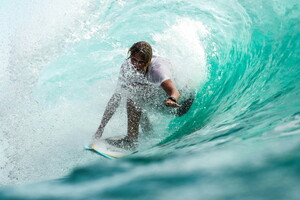
9. How long does it take to learn to surf?
The time it takes to learn to surf can vary considerably from one person to another, depending on a number of factors. Firstly, previous experience of water or board sports can play an important role. People who have already practised activities such as skateboarding, snowboarding or even swimming may find that they adapt more quickly to the sensation of gliding over water.
The frequency of lessons also plays a key role. Frequent surfing sessions, ideally several times a week, actually encourage progress. This allows students to consolidate their skills and adapt more quickly to different types of waves and weather conditions.
It's also essential to take into account each individual's physical condition and ability to learn. People who are already physically active may have a faster learning curve.
In short, each student progresses at their own pace. The key is patience, perseverance and a passion for this activity, which is as much a physical challenge as it is a true art of living.

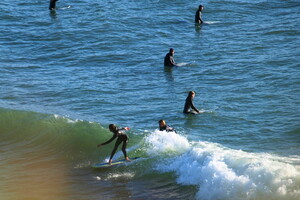
10. What are the safety rules for beginners?
Learning to surf is an exciting adventure, but it also requires particular attention to safety, especially for beginners. Here is a detailed explanation of the main safety rules to follow:
- Never surf alone: there are many safety advantages to surfing accompanied. In the event of a problem, such as an injury or sudden fatigue, the presence of a partner means you can get immediate help. What's more, surfing in a group is encouraging and reduces the anxiety often associated with taking up a new sport.
- Always check the surfing conditions before getting into the water: before taking the plunge, it's essential to find out about local surfing conditions, including wave size, current and tides. This can include wind conditions, water temperature and even the presence of dangerous currents such as riptides. Beginners should favour days when the waves are small and manageable, and avoid surfing in extreme conditions.
- Observe and respect other surfers in the water: surfing is a sport that is practised in a shared environment, which means that it is essential to know the rules of courtesy at sea. Observing the behaviour of other surfers also helps you to better understand the dynamics of the water and to anticipate wave movements and wind influences. Good communication between surfers, such as hand signals or gestures, is also essential to ensure everyone's safety.

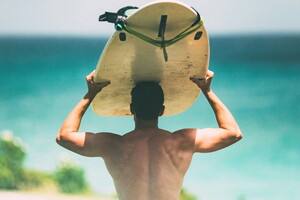
11. Is physical preparation compulsory for surfing?
Physical preparation, although not strictly compulsory for apprentice surfers, plays a crucial role in improving experience and performance on the board. First of all, it's important to understand that surfing involves a wide range of muscle groups and requires fine coordination, endurance and agility. So investing in the right physical preparation can make it much easier to learn basic techniques and progress to more advanced manoeuvres.
Indeed, good physical condition enables beginner surfers to better manage the challenges inherent in the sport. For example, a good level of cardiovascular endurance helps to sustain prolonged activity in the water, which is essential for paddling and positioning yourself on the board without tiring too quickly. In addition, muscular strength, particularly in the arms, legs and trunk, is essential for maintaining balance on the board and performing dynamic movements such as the pop-up (the movement of standing up on the board).
Finally, physical preparation also offers mental benefits. By improving their physical condition, apprentice surfers gain in confidence and independence, which contributes to their overall enjoyment of the sport. A fit and strong body helps to reduce the stress and anxiety often associated with first experiences on the waves.


12. Which wetsuit to choose...
When you're new to surfing, the choice of wetsuit is essential, as it influences both comfort and performance on the water. Neoprene wetsuits are often considered to be the must-have equipment for surfers, for a number of reasons. Firstly, it's important to take into account the temperature of the water in which you're going to be surfing. In general, the colder the water, the thicker the wetsuit needs to be. For example, in temperate waters, a 3/2 mm wetsuit (three millimetres on the torso and two millimetres on the arms and legs) will often be sufficient, whereas if you're in cooler waters, a 4/3 mm or even 5/4 mm wetsuit will be more appropriate.
As well as thickness, the style of wetsuit is also a factor to consider. Full-body suits, which cover the whole body, offer better protection against the cold, while short-sleeved, short-legged shorts may be sufficient on warmer days or for sessions in more temperate waters. Beginners could also opt for models with zips at the back, as they are generally easier to put on and take off.

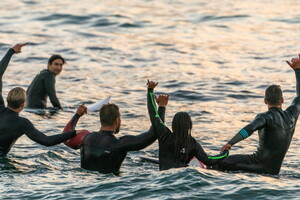
... when you're a beginner surfer?
Neoprene is an insulating material that traps a thin layer of water between the skin and the wetsuit, with the water heating up quickly thanks to body heat. This keeps the surfer warm while allowing some freedom of movement, which is vital for beginners and advanced surfers alike. Some wetsuits also come with fleece linings or extra features, such as sealed seams, which increase thermal insulation and water resistance.
It's also important to consider the suit's fit. A well-fitting suit is crucial: if it's too loose, water will get in and chill you, while a suit that's too close to the body could restrict your movement and cause chafing. Specialist surf shops often have advisers who can help you choose the size and model that best suits your body shape.
Finally, don't forget to pay attention to the extra details. Some wetsuits have features such as underarm or knee chafing protection, which is particularly beneficial for beginners who risk falling off more often and rubbing against the board. All in all, choosing the right wetsuit for beginner surfing is key to getting the most out of this activity, allowing you to concentrate on your first attempts without being distracted by physical discomfort.


13. What type of surfboard to choose...
Choosing the right surfboard is a crucial step for any beginner wishing to take up this exciting sport. Surfboards designed for beginners are distinguished by their design, which focuses on stability and ease of use. In general, these boards are wider and longer than those designed for more experienced surfers. This increased width increases the water surface area, making it easier to balance on the board, which is essential for beginners who haven't yet acquired the reflexes needed to ride the waves.
In addition, greater length contributes to straight-line stability. This means that a beginner surfer will be able to get up and stay up more easily, even in moderate wave conditions. Beginners often face challenges such as the timing of standing up and managing balance. A bigger board helps to minimise these difficulties, boosting confidence while allowing you to concentrate more on technique and posture.


... when you're an apprentice surfer?
Among the types of boards recommended for the first steps in novice surfing, foam boards are particularly suitable for beginners. These boards are often more shock-absorbent, which reduces the risk of injury from falls, which are common among beginners. Their foam material also makes the boards lighter and easier to handle, both in the water and on the beach, which is an undeniable advantage for those who haven't yet developed their strength or stamina.
By opting for a foam board, beginners also benefit from a price that is often more affordable than boards made from more sophisticated composite materials, a significant advantage for those who haven't yet decided to invest more in their equipment. These foam boards are therefore an excellent introduction to beginner surfing, allowing beginners to familiarise themselves with the practice without breaking the bank and in complete safety.
To sum up, when choosing a surfboard suitable for beginners, it's advisable to opt for wider and longer models, preferably made from foam, to ensure a more enjoyable and less intimidating learning experience.


14. How to read the weather forecast...
To maximise your chances of enjoying the best surfing conditions for beginners, it's essential to read and understand the weather forecast:
- Wave height: wave height is a crucial indicator of the quality of surf sessions. In general, waves between one and two metres high are ideal for most surfers. However, this also depends on your skill level and the type of waves you're looking for.
- Wind direction: wind plays a fundamental role in wave formation and quality. An offshore wind (a wind that blows from land to sea) is considered ideal, as it helps to smooth out the waves and improve their shape. Conversely, an onshore wind (one that blows from sea to land) can cause disordered waves, making surfing less enjoyable. Forecasts will often give the wind direction (north, south, east, west) as well as its strength, usually measured in knots. Look for conditions where the wind strength does not exceed 15 knots to maximise your chances of getting quality waves.

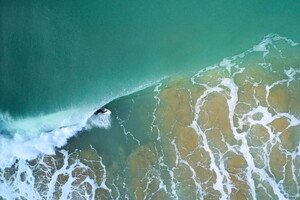
... for the best surfing conditions?
- Type of waves: as well as wind height and direction, it's important to know the type of waves you'll encounter. Waves can be divided into different categories, such as breaking waves (which break on a sand or coral bottom) and white water waves (often formed on reefs or plateaus). Each type of wave requires different skills and different boards. For example, breaking waves are often more suited to beginner surfers while white water waves may be more suitable for advanced surfers. Forecasts will often include terms such as "beach waves", "reef break" or "point break", allowing surfers to choose the spots that suit their abilities.
- Tides: tides also have a major impact on surfing conditions. Some beaches work best at high tide, while others are ideal at low tide. You can often find marine forecasts indicating tide times and heights on weather forecasting websites. Understanding the role of the tides will help you plan your surfing session for beginners at optimum times.
- Weather systems: finally, keep an eye out for current weather systems, such as lows or storms, as they can increase wave size and alter overall conditions. Specialist surfing sites will often provide reports and medium-term forecasts to help you anticipate the best conditions and make the most of them.


15. Our tips for understanding how waves work
Understanding how waves work is essential to getting the most out of your water activities. Here's some detailed advice on how to get to grips with the different types of wave and how to tackle the sea safely.
Recognising the types of wave
Waves are formed by the action of the wind on the surface of the water. Their shape, size and power depend on a number of factors, such as the swell, the seabed and weather conditions. So it's vital to know how to recognise the different types of wave:
- Small waves (knee waves): these are generally waves measuring between 30 centimetres and one metre. They are ideal for beginners, as they offer a more controlled environment in which to practise swimming, bodysurfing or surfing for beginners. These waves allow you to learn the basics without major risk, perfect for perfecting your balance and technique.
- Breaking waves: these can be several metres high and are often more powerful and capable of causing danger. When the wave breaks, it forms a 'bar' and eventually crashes onto the shore. To tackle these waves, it's crucial to have a certain amount of experience and to know the right techniques for surfing or swimming safely. These waves require not only physical strength but also a good understanding of currents and the influences of the seabed.


Assess ocean conditions
- Wave size: check how high the waves are and how often they break. Ask experienced surfers or local lifeguards for advice on the day's waves.
- Currents: some areas can have strong currents that can sweep swimmers away. Be vigilant and look out for natural signs, such as areas where the water is murkier or choppy, which may indicate the presence of a current.
Choosing the right time
- At high tide: waves can become more powerful and riskier to tackle, especially in areas with rocky bottoms.
- At low tide: waves can be gentler and more suitable for beginners.
Learn specific techniques
When the waves become more demanding, it's essential to master certain techniques:
- The duck dive: this technique allows surfers to dive under a breaking wave to avoid being thrown backwards. It's a skill that requires practice and good synchronisation.
- The take-off: for breaking waves, it's crucial to know how to catch a wave at the right moment, using the right body position to get up quickly on the board.

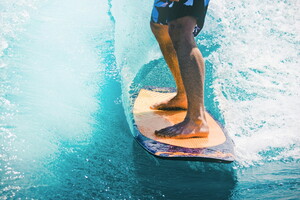
16. What's the difference between goofy and regular?
When it comes to surfing, the way a surfer positions themselves on their board is crucial to their performance and balance. Surfers can be divided into two main categories according to the position of their front foot: "regular" surfers and "goofy" surfers.
- Regular" surfers stand with their left foot forward. This configuration allows the surfer to steer the board with greater fluidity and control, especially when performing manoeuvres that require turning or changing direction quickly. Rear leg movements also become more dynamic, offering greater stability in the waves.
- Goofy surfers adopt the opposite posture, with their right foot forward. This position is just as valid and strategic. Surfers who choose this approach generally find that their right foot, being forward, allows them to navigate better on waves that open up to the right or to engage more comfortably in certain types of manoeuvre.
There is often a personal preference behind the choice of one position or another, which can be influenced by sporting history, anticipated activities, or simply by the way the body feels most comfortable. It is therefore essential, especially for beginners, to identify their natural position from the outset. This awareness can influence not only the choice of board, but also training techniques and progress in the sport.

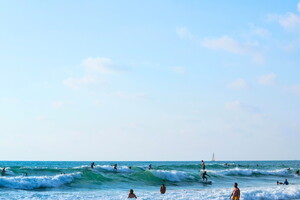
17. Why surf moss when you're just starting out?
Surfing foam waves is often recommended for beginners for several fundamental reasons that promote learning and safety on the water.
✅ Foam waves, also known as breaking waves, are formed when waves reach the beach and start to break. They have significantly less power than waves formed by larger swells. This characteristic makes surfing for beginners less intimidating, as the force of the water is less likely to knock them over or drag them under.
✅ Surfing foam waves allows beginners to concentrate better on their techniques. The movements to be mastered, such as positioning on the board, foot placement, balance and when to "take off" (the moment when you stand up on the board), are essential skills to develop. When these moves are practised in a less demanding environment, it becomes easier to learn in a gradual and considered way, and build self-confidence.
✅ Foam waves give novice surfers the chance to get used to the sensations of surfing without the risks associated with larger, more powerful waves. It also gives them a better understanding of wave timing and dynamics, key concepts for progressing in their beginner surfing.
✅ Surfing foam waves also promotes greater redundancy in wave catching. Because these waves are less aggressive, beginners are more likely to successfully catch waves several times during the same session, increasing their practice time and allowing them to familiarise themselves with beginner surfing in a more fun and effective way.

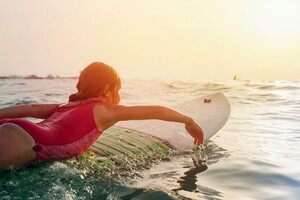
18. What does "rowing" mean when you start surfing?
"Paddling" in the context of surfing is a fundamental skill for any surfer, whether beginner or experienced. When we talk about rowing, we are specifically referring to the action of paddling with the arms to propel oneself through the water, in order to position oneself in the right place to catch a wave.
1️⃣ Paddling enables you to navigate efficiently towards the spot where the waves are forming. Surfers often have to cross an area called a "break", where the waves break, to reach a woolly area where the waves are gentler and more exploitable. By using an efficient paddling technique, surfers can move quickly and avoid being swept away by the power of the waves.
2️⃣ Timing and position play a crucial role in surfing. Paddling allows surfers to position themselves at the exact spot where the wave will rise, giving them an opportunity to ride it. This requires a good appreciation of the movement of the water and a sense of timing to paddle at the right moment, synchronising the movement with the arrival of the wave.
3️⃣ The paddling technique itself involves using the arms in a fluid, coordinated movement. The surfer leans forward on his board, hands in the water, and performs paddling movements by alternating arms, while maintaining good balance. Good posture is essential. What's more, arm strength and endurance are put to the test, especially in difficult conditions or over long distances.

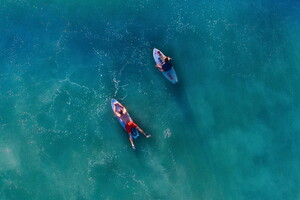
19. How do you stand up on the board ("take off")?
Standing up on a surfboard, also known as "taking off", is a fundamental step in learning to surf that requires coordination, balance and timing. Practising this technique out of the water, on the beach, can greatly improve your confidence and skill when you're out in the ocean.
To start, find a large, clear area of sand away from distractions. Lie face down on the board, making sure your hands are under your shoulders and your feet are wide apart so that you are stable. Once you're comfortable in this position, start the exercise.
From the lying position, bend your arms and use the strength of your arms to push yourself upwards while keeping your hips down to avoid tipping over. The movement should be fluid and synchronised: as you stand up, place one foot in the centre of the plank, followed by the other. As you stand up, make sure you keep your weight centred over the board; this will help you maintain your balance in your beginner's surf.
Once you're upright, bend your knees slightly to lower your centre of gravity, which will further improve your stability. It's also essential to look forward, rather than down, as this will help you to anticipate board movements and waves better.

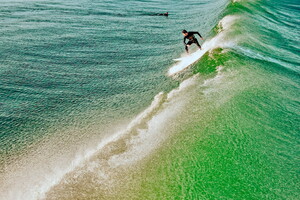
20. How do you steer towards the green waves?
- Observe the environment: before you even set off towards the waves, take the time to observe the area where you want to surf. Identify the series of waves, the calm moments between them and the best moment to launch yourself.
- Paddle hard: once you're ready to go, start paddling hard. Use your arms to pull the water backwards, synchronising your movements to maximise your speed.
- Use your body weight: lean slightly forward as you approach a wave to stabilise your board and keep it on a straight path. If you're facing a wave, move your centre of gravity closer to the back of the board so that it can climb it better without flipping over.
- Wave management: adjust your position on the board according to the height of the wave. If the wave is coming from the front, you may need to lean or lie back a little more on the board so that it passes under the crest of the wave.
- Reassure your mind: passing the bar can generate adrenaline and sometimes anxiety, especially for beginners. Take a deep breath, stay relaxed and concentrate on your technique. Self-confidence and stress management are important for coping with the force of the waves.
- Adaptation and repetition: Finally, it's important to remember that every surf session is unique. Don't be discouraged by failures and know that, with practice, your technique will improve.

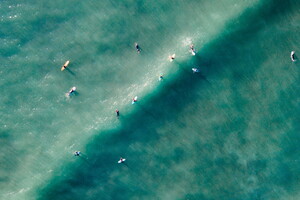
21. What are the rules of priority when surfing?
Surfing is not only an individual sport, but also a social activity based on rules of courtesy and safety, which are essential to guarantee a positive experience for all those who share the ocean. One of the most fundamental rules of priority is that of proximity to the wave: the surfer who is closest to the peak where the wave breaks has priority. This rule is crucial for avoiding collisions and maintaining a safe environment for all surfers.
Good manners in the water are not just about respecting the right of way. It also includes behaving courteously and respectfully towards other surfers. Avoid getting in the way of other surfers by catching a wave that doesn't belong to you or by standing between a surfer and the wave he or she is about to catch. This kind of behaviour can lead to tension, arguments and, in the worst cases, accidents. Be vigilant when surfing for beginners.
It's also important to communicate with other surfers. A simple hand gesture can signal your intention to catch a wave or abandon your position. If you find yourself in a situation where you're not sure what the other surfer is going to do, don't hesitate to make eye contact to avoid any confusion.

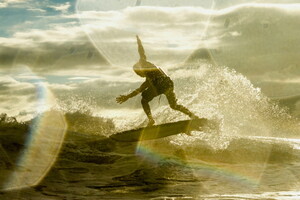
22. How do you manage surfing when there are lots of people in the water?
- Stay focused on your surfing: taking the time to breathe deeply and ground yourself in the present moment can help you improve your concentration. Visualise your manoeuvres, practise your balance and keep your goals clear, whether that's improving your technique or simply enjoying the waves.
- Wait your turn: watching other surfers is a key skill: assess their movements and try to predict when they'll catch a wave. This will help you to position yourself wisely and not take priority away from others.
- Keep your distance from other surfers: when many surfers are in the same area, it's vital to maintain a safe distance. If you find yourself in a dense group, take a few moments to shift your position and give yourself a better angle for the wave ahead.
- Communicate with other surfers: don't hesitate to wave or make eye contact with other surfers to signal your intentions.
- Choose less busy times: if you find that surfing during peak hours becomes too stressful, consider scheduling your beginner surf sessions during less busy times, such as early morning or late afternoon.
- Stay patient and positive: patience is an essential virtue in surfing, and even more so when the water is crowded. Bear in mind that every surfer is there to experience a good feeling.


23. How do beginners catch a wave?
- Wave observation and selection: look for waves that are about to break, generally those with a well-defined cove. Taking wind direction and current into account is essential: they can influence how the perfect wave will form. This is important whether you're a beginner or an experienced surfer.
- Positioning on the board: lie down on the wave, making sure your body is centred and balanced. Your feet should be close to the tail (the back of the board), while keeping your face facing forward.
- Paddle for position: this movement should be energetic and rhythmic, synchronised and powerful. This will help you build up speed and position yourself on the shoulder of the wave, the part where it starts to break.
- The decisive moment: when you feel the wave lift you, that's the signal to stand up. This transition should be quick: push on your arms to lift your body while redistributing your weight backwards and bending your knees.
- Standing up: keep your feet shoulder-width apart for balance. Generally, the back foot is placed on the tail for more control, while the other remains forward to steer the board.
- Balancing and navigating the wave: lean your body slightly forward to go faster or backwards to slow down. Use your shoulders and hips to steer the board towards the wave and for manoeuvres.
- Taking risks and adapting: don't be afraid to make mistakes, because catching waves takes practice. Stay alert and adaptable, learning to read the sea's movements will help you react quickly.

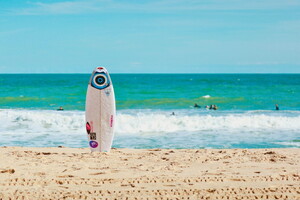
24. Where are the best places to learn to surf?
The beaches in the area, particularly those around the Lou Pignada campsite, offer excellent spots for beginners thanks to their small waves.
📍 Messanges: a natural setting for beginners to learn to surf. Located just a stone's throw from the ocean beaches, Messanges is a peaceful destination that appeals to surf enthusiasts looking for tranquillity. Thanks to its accessible waves and friendly atmosphere, the Messanges beach is perfectly suited to beginners. The less-frequented spots offer ideal conditions for learning, while taking advantage of the exceptional natural surroundings. Whether you're surfing solo or with the family, Messanges offers you the opportunity to experience your first moments of beginner surfing in complete serenity.
📍 Hossegor: the temple of surfing, the gentle version. Although busier in high season, Hossegor has several areas suitable for beginners. Plage de la Gravière is famous for its big waves, but the adjacent beaches, such as Plage de la Sud, offer gentler conditions, perfect for those new to surfing.
📍 Capbreton: ideal for first-time surfers. Capbreton combines surfing and conviviality, with a relaxed and festive atmosphere. The central beach offers easy waves to surf, ideal for learning. The shores of the port can also offer interesting conditions for beginners.


25. Is it possible to learn to surf the Internet online?
Although the internet is full of a variety of surfing content, it's important to recognise the limitations of this type of learning. While these resources can provide a useful introduction to the fundamentals of surfing, they cannot replicate the tactile and sensory experience that is gained by actually surfing.
Hands-on learning is crucial for a number of reasons. Firstly, surfing is a sport that relies heavily on coordination, balance and adaptation to ocean conditions. The feel of the wave lifting you up, the way the board responds to your weight and movement, and even how to interact with other surfers cannot be fully understood without first-hand experience.
What's more, surf lessons offered by experienced instructors provide personalised advice tailored to your specific level and needs. In addition, surf schools often offer equipment support, such as adapted boards and wetsuits, which is a considerable advantage for beginners who don't yet own their own equipment.
In conclusion, although e-learning can be a useful first step in your surfing journey, it should not be seen as a stand-alone solution. To gain real skills and experience in novice surfing, it's essential to invest time in practical lessons supervised by professionals who can guide and support you as you learn.

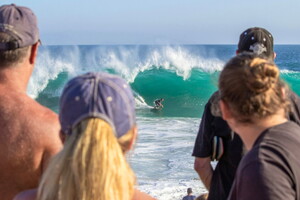
26. Surfing for beginners means giving yourself the means to succeed
To sum up, here's some practical advice on how to get started:
- Choose the right season: spring and autumn are generally the best months to start, with gentler surf and fewer crowds.
- The right equipment: invest in a wider, more stable soft-top board suitable for beginners.
- Safety first: always listen to your instructor's advice and be aware of the marine environment (currents, tides).
- Patience and perseverance: surfing is a technical sport that takes time to improve. Don't be too hard on yourself during your first few sessions.
In conclusion, surfing for beginners is accessible to everyone, even if you have years of catching up to do. With the right equipment, the right lessons and a bit of determination, you're ready to get out there and start surfing. So put on your wetsuit, choose your board and get ready to conquer your first wave!

